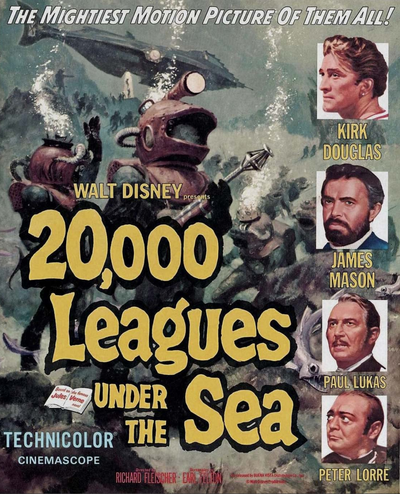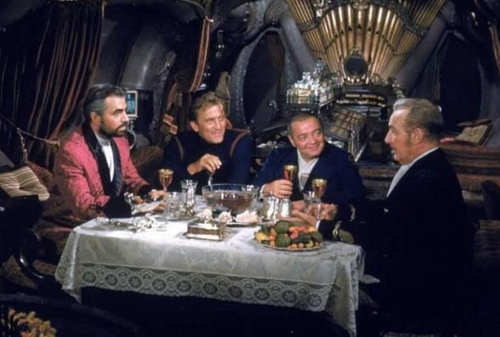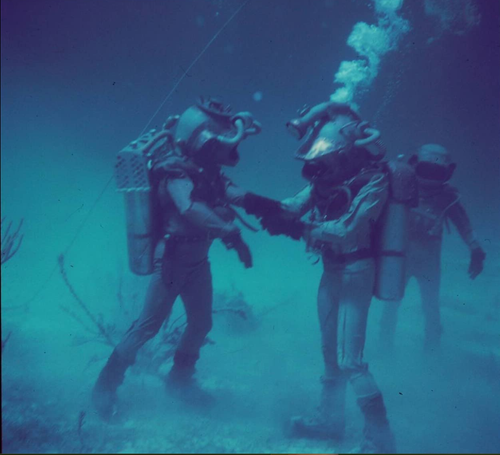Review of 20,000 Leagues Under the Sea (1954)
It’s been quite a few years since I saw 20,000 Leagues Under the Sea (1954), so long ago all I remembered of it was that Kirk Douglas and Peter Lorre were in it, and the design of the Nautilus, although that last is more likely due to having a copy of the blue print of the Nautilus packed away.
I also remember starting to read Jules Verne’s novel when I was around 10 or 11 years old and couldn’t get into it; surprisingly, my daughter, Little Miss, has read the novel recently. She is one up on me there. Back to the film!

20,000 Leagues Under the Sea poster - IMDB
20,000 Leagues Under the Sea stars James Mason as Captain Nemo, while Douglas plays a sailor named Ned Land and Peter Lorre a scientist named Conseil. Conseil is also the assistant to Professor Aronnax, played by Paul Lukas, an actor I am unfamiliar with. Nemo’s First Mate is played by Robert Wilke, whom I have seen in quite a few movies in supporting roles, mostly westerns. Together, these five men make up the mainline cast of the film, and all of them turn in solid performances. Douglas even gets to sing a couple of songs in the film, adding a touch of humor as the drama unfolds.

Mason, Douglas, Lorre, Lukas - IMDB
We get glimpses into Nemo’s past and his motivations as to why he is destroying ships, and some of his character flaws – a desire for revenge, a hatred for imperialism, war and slavery, topped with a mistrust of humanity. We also learn why Nemo’s crew is completely loyal to him, right up to the bitter end.
Aronnax is quite impressed with Nemo’s accomplishments, while Land doesn’t trust Nemo and wants to escape the Nautilus, preferably with a pocket full of treasure that is stored onboard the Nautilus. Conseil is conflicted between his desire to escape with Land, and his loyalty to Aronnax.

The Nautilus - IMDB
The Nautilus stands out as a beautifully designed concept submarine, so much so in the film that it is easy to see how it could be mistaken as a Sea Monster, with forward observation decks glowing green like a pair of gleaming, demonic, eyes as it rushes towards a ship on the attack. Along with the jagged top, and scaly hull, coming out of the night would give anyone a bit of the creeps. The interior sets for the Nautilus are a mix of cramped utility, efficient in nature, like a real submarine, and spacious luxury, which is quite a contrast. Powered by an atomic reactor (which conflicts with Verne’s vision of powering the Nautilus as atomic power was far from anyone’s imagination at the time), the reactor room design fits well with the overall design of the Nautilus.

Divers from the Nautilus - IMDB
The undersea shots are some of the best scenes in the film, especially when the crew is working underwater in their diving gear, which is a blend of scuba gear and hardhat diving gear, modern diving meets steampunk. Wicked cool looking and stunningly beautiful. The farming scene is interesting, and well thought out, harvesting plants, and other sea life (although I felt very sorry for the sea turtles being carried by the crew to the Nautilus for dinner), which Nemo and his crew use to sustain themselves without relying on surface agriculture, keeping with Nemo’s desire to avoid contact with the nation’s of the Earth and maintaining their independence. Even Nemo’s cigars are made from the products of the sea. It’s attention to little details like the cigars that shows what a great deal of thought went into the story.
Overall I found 20,000 Leagues Under the Sea to be a wonderful film, both in storytelling and performances from a fine cast, in addition to being visually stunning, in many ways better than a lot of science fiction films being produced today with modern filming techniques.
Hopefully you enjoyed my look at 20,000 Leagues Under the Sea. Thanks for stopping by,
Posted using CineTV